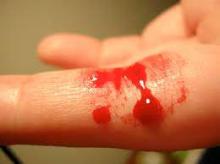Patients with severe hemophilia A treated with plasma-derived factor VIII, as compared with recombinant factor VIII, had a lower risk of developing neutralizing antibodies, based on a recent report from the randomized SIPPET trial published in the New England Journal of Medicine.
In a second study, also published in the journal, prophylactic treatment with the bispecific antibody emicizumab decreased bleeding in patients with or without neutralizing antibodies.
Of 125 patients with severe hemophilia A who were treated with plasma-derived factor VIII with von Willebrand factor, 29 (23.2%) developed inhibitors, compared with 47 of 126 patients (37.3%) treated with recombinant factor VIII. In the plasma-derived group, 20 (16.0%) had high-titer inhibitors compared with 30 (23.8%) in the recombinant group. Cox regression models showed an 87% higher rate of inhibitor development with recombinant factor VIII (hazard ratio, 1.87; 95% confidence interval, 1.17-2.96). For development of high-titer inhibitors, the HR was 1.69 (95% CI, 0.96-2.98).
Previous observational studies have suggested greater immunogenicity of recombinant vs. plasm-derived factor VIII, but the results remained inconclusive. Meta-analyses of studies have been hindered by differences in design, enrollment criteria, definition of hemophilia A, sample size, method of inhibitor detection, and intervals of follow-up testing, according to Dr. Flora Peyvandi of the IRCCS Maggiore Hospital, University of Milan and colleagues. “Our trial was specifically designed to compare the immunogenicity of factor VIII products. As a result of randomization, the main risk factors for inhibitor development were evenly distributed between the two factor VIII classes,” they wrote, adding, “The finding that native factor VIII products from human plasma are less immunogenic than those engineered by recombinant DNA technology in animal cell lines has the potential to affect treatment strategies and open new investigations to better understand the mechanisms of the immunogenicity of various factor VIII preparations.” (N Engl J Med. 2016 May 25. doi: 10.1200/JCO.2015.64.0730).
The Survey of Inhibitors in Plasma-Product Exposed Toddlers (SIPPET) clinical trial randomized 251 patients with severe hemophilia A who received infusions of plasma-derived or recombinant factor VIII. The investigators found no association between risk of inhibitor development and race, intensity of treatment, or age at first treatment.
The second study, a 12-week dose-escalation trial of emicizumab, included 18 patients with severe hemophilia A, aged 12-59 years. Patients were assigned to one of three cohorts and received a once-weekly subcutaneous dose of 0.3, 1, or 3 mg per kilogram of body weight. During prophylactic emicizumab treatment, median annualized bleeding rates decreased from 32.5 (range, 8.1-77.1) to 4.4 (0.0-59.5) in cohort 1, from 18.3 (range, 10.1-38.6) to 0.0 (range, 0.0-4.3) in cohort 2, and from 15.2 (range, 0.0-32.5) to 0.0 (range, 0.0-4.2) in cohort 3. The annualized bleeding rate decreased regardless of factor VIII inhibitor status. Of 11 patients with factor VIII inhibitors, 8 (73%) had no bleeding episodes; 5 of 7 patients without factor VIII inhibitors (71%) had no bleeding episodes.
“This study showed that once-weekly subcutaneous administration of emicizumab as prophylaxis is safe and has the potential to reduce or prevent bleeding episodes in patients who have severe hemophilia A with or without factor VIII inhibitors,” wrote Dr. Midori Shima of Nara Medical University, Kashihara, Japan, and colleagues (N. Engl J Med. 2016 May 25. doi: 10.1056/NEJMoa1511769).
Emicizumab had an acceptable safety profile. In total, 43 adverse events were reported in 15 of 18 patients. All were mild, except two moderate events – an upper respiratory tract infection and a headache. Events thought to be treatment related included malaise, injection-site erythema, injection-site rash, diarrhea, increased C-reactive protein level, and increased blood creatine kinase level.
Dr. Peyvandi and coauthors disclosed consulting, advising, research funding and other relationships with several industry sources, including Grifols, Kedrion, and LFB. Dr. Shima and coauthors disclosed consulting, advising, research funding and other relationships with several industry sources, including Chugai Pharmaceuticals, which supported the study.


